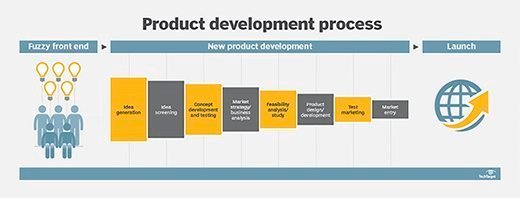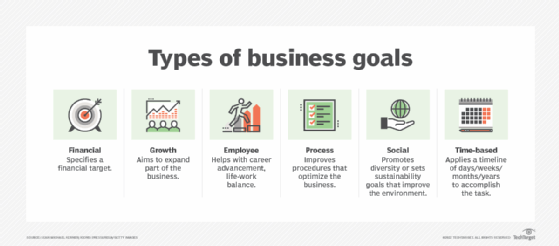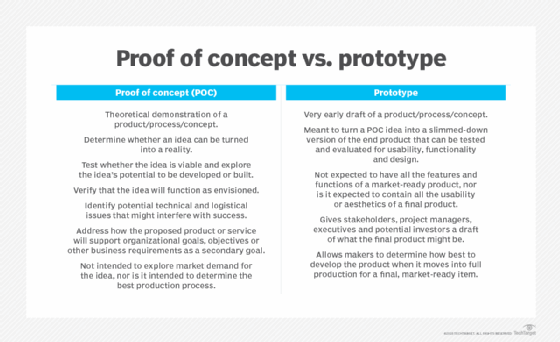proof of concept (POC) (original) (raw)
What is a proof of concept (POC)?
A proof of concept (POC) is a demonstration of a product in which work is focused on determining whether an idea can be turned into a reality. A POC's goal is not to seek market demand for the concept or choose the best way to produce it. Rather than focusing on building or developing the idea, it tests whether the idea is feasible and viable. In addition, it enables those involved in the proof-of-concept exercise to explore its financial potential.
POCs are an important part of the product development process for an organization. They are commonly small and are created by employees or team leaders. Project managers can also use POC documents as a framework while creating a product development process. Many industries, including the hardware, drug discovery, manufacturing, science and engineering sectors use the POC process to pursue ideas before approving them for further testing and, eventually, full-scale production.
A POC typically requires time or other resources, such as supporting technologies or necessary physical components. Focusing on a project's viability, a POC should demonstrate that the initial idea or concept would meet customer and business requirements. Teams creating POCs should also collect user feedback and team insights.
Proof of concept is sometimes also known as a proof of principle.

Proof of concept is often a key part of the product development process.
The value of a proof of concept
The proof of concept is the first point where an organization can check if an idea has a chance of succeeding. Going through this process enables companies to determine an idea's practicality before putting production-level resources behind an untested hypothesis.
Developing a POC can help a product owner identify potential technical and logistical issues that might interfere with success. An organization can also solicit internal feedback about a product or service while minimizing unnecessary risk.
As a result, stakeholders can assess design choices early in the development process. The individual or team going through the process can then use a successful POC to convince stakeholders, managers or investors that the core idea is worth pursuing.
In software development, for example, a proof of concept would show whether an idea is feasible from a technology standpoint. For startups, a POC could demonstrate financial viability. If a POC does not meet an organization's standards, that organization would save the time and money of investing in an idea that wouldn't meet requirements.
Steps to write a proof of concept
A POC plan could address how a proposed product or service will support organizational goals, financial objectives or other business requirements. However, there are no standardized step-by-step processes on how to write a proof of concept. As a general example of how to write a POC, they should include the following:
- Define the POC idea, including what the idea is trying to achieve, objectives and resources needed.
- Determine the scope of the POC process to evaluate the project clearly.
- Clearly define criteria for success with use cases within the scope.
- Identify and organize the involved team, including those in decision-making processes, production processes as well as stakeholders.
- Estimate the time duration the POC will take place as well as the efforts that will need to be put into the project.
- Evaluate the POC by collecting user feedback and team insights -- if a project idea needs work, this is a moment before development to make changes.
- Create a proposal for how to move forward should the POC prove successful.
A well-crafted POC is crucial to ensuring the best possible execution of a product or service.
The constructed POC should be able to answer if the idea can be reliably produced, if there is a potential market for the idea, if the idea would work as predicted, what technology is necessary to run the idea and if there is potential feedback.

Developing a proof-of-concept plan could address how a proposed product or service will support organizational goals or other business requirements.
Proof of concept vs. prototype
Although the terms proof of concept and prototype are sometimes used interchangeably, they are processes meant to produce different results and serve different purposes.
The purpose of a proof of concept is to help decide whether the idea is feasible and to ensure it will work as intended.
In contrast, the purpose of a prototype is to test the usability, functionality and design of a working model. There is no expectation that prototypes will have the same features, functions, usability or aesthetics as a finished product. Instead, it gives stakeholders, such as project managers, executives and potential investors, a draft of the final product. A prototype lets makers determine how best to develop the product when it moves into full production for a final, market-ready item.
While a POC is a process that proves an idea is viable, a prototype is a physical model that shows the production of that idea is practical.

A proof of concept differs from a prototypes in that a POC proves an idea is viable, while a prototype is a physical model to show that production is practical.
Similarly, a minimum viable product (MVP) comes after a successful proof of concept. MVPs are early versions of the final product but are more refined than prototypes. Potential clients and users can test and provide feedback on the MVP's marketability and usability.
Learn more about how to create a proof of concept using six templates in this article.
This was last updated in March 2023
Continue Reading About proof of concept (POC)
- Forescout proof-of-concept ransomware attack affects IoT, OT
- How to kickstart a proof-of-concept IT project
- Break out of IoT proof-of-concept purgatory
- How software prototyping beats requirements gathering
- Rapid prototyping process brings technology to life
 MVP vs. prototype: What's the difference? By: Darcy DeClute
MVP vs. prototype: What's the difference? By: Darcy DeClute  How to create a proof of concept with 6 free templates
How to create a proof of concept with 6 free templates  By: Gabriella Frick
By: Gabriella Frick  How to make a strong business case for software projects
How to make a strong business case for software projects  By: Matt Heusser
By: Matt Heusser  How to kickstart a proof-of-concept IT project
How to kickstart a proof-of-concept IT project  By: Stephen Bigelow
By: Stephen Bigelow